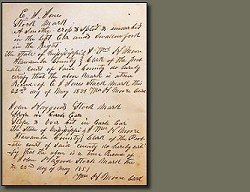 In researching an ancestor’s real estate in Itawamba County, many researchers rely on Federal land patents alone, but this type of record only tells part of the story, and in some instances can be misleading.
In researching an ancestor’s real estate in Itawamba County, many researchers rely on Federal land patents alone, but this type of record only tells part of the story, and in some instances can be misleading.Always remember that a Federal land patent is where a person simply obtained land and does not necessarily mean the person actually lived on that land. In addition, the patentees of adjoining sections of lands were not necessarily neighbors.
Always remember that in many instances, land was obtained through patents by land speculators, especially in the newly opened Chickasaw Cession counties of northeast Mississippi. These patentees never intended to live on the land, but the purchase of these lands through the Federal land office was simply a financial investment with the idea of later reselling the land to settlers at a profit. The records show that these speculators lived in other states in addition to Mississippi and many as far away as New York.
However, one valuable record group in Mississippi counties relating to land purchases is the collection of Range Abstract books. Itawamba County lands were found in six ranges east of the Chickasaw Meridian (six through eleven). A range abstract book will have a section for each township, and within each township section an entire page devoted to each section of land. Each land section page has four columns - one for each quarter section of land within the section (northwest, northeast, southwest and southeast quarters). The top of each column has the original patentee’s name and date the land was obtained. Under this information, in chronological order, is a running title of the particular quarter section of land giving the grantee’s name and deed reference.

If a researcher has an old deed reference to an ancestor’s land, this land can be easily researched in the Range Abstract books giving a reference for when the land was sold, and to whom the land was sold. This book will also show the length of time the ancestor owned the property. These books are also valuable in giving a more accurate account of who an ancestor’s neighbors were, at any given time.
In researching your Itawamba County ancestors’ land, always remember the Range Abstract books – a most valuable often-overlooked resource that tells so much more than the patent records.





























